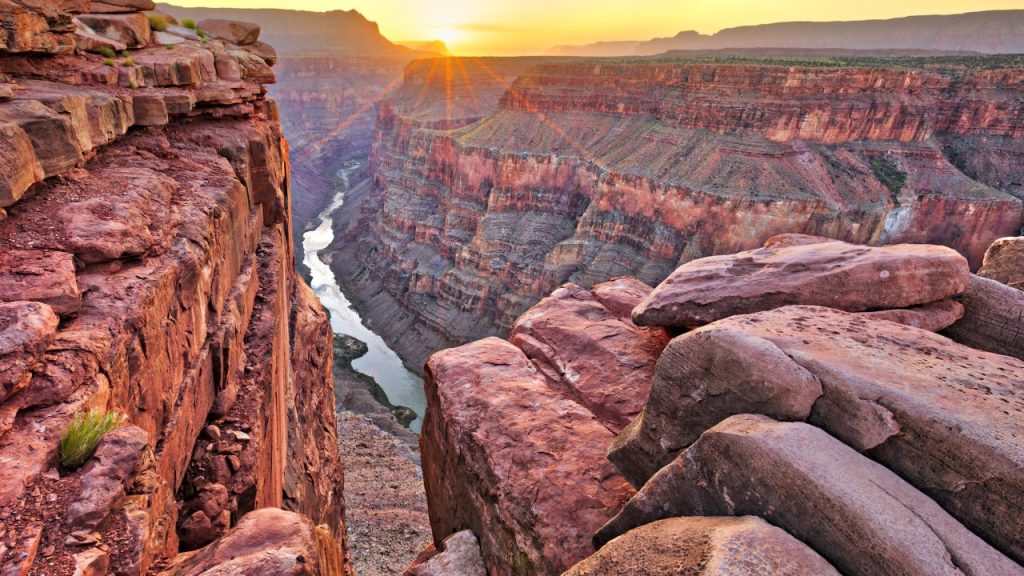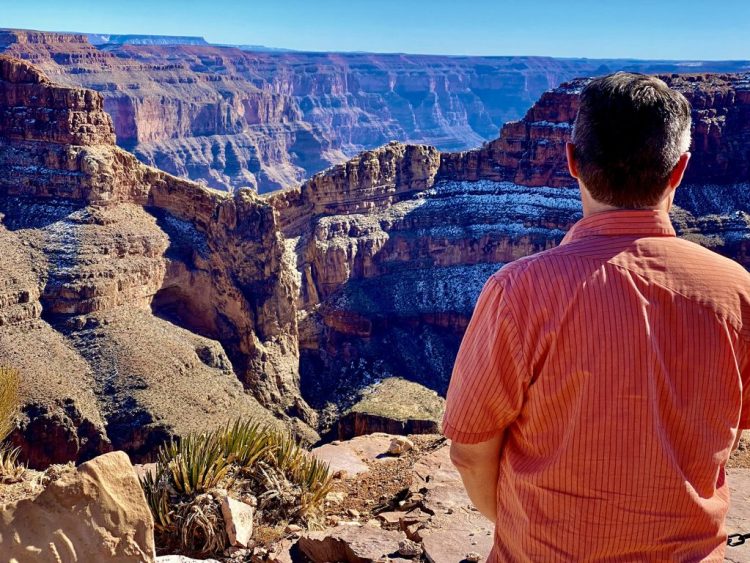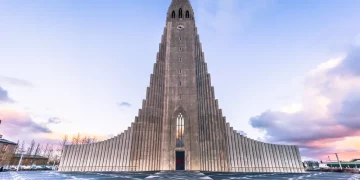Introduction
The Grand Canyon National Park is one of the most awe-inspiring and iconic natural wonders in the world. Carved over millions of years by the Colorado River, it is a place where visitors are treated to jaw-dropping vistas, incredible geological formations, and an ecosystem teeming with wildlife. This guide will cover everything you need to know about visiting the Grand Canyon, from getting there, when to visit, what to do, where to stay, and essential tips to make the most of your trip.
1. What Makes Grand Canyon National Park a Must-See Destination?
1.1 Geological Wonder
The Grand Canyon is famous for its immense size and vivid colors. It stretches for over 277 miles, with depths exceeding a mile, and covers an area of 1,900 square miles. The canyon walls expose 2 billion years of Earth’s history, offering a unique look into the planet’s geological evolution. From the vibrant reds and oranges of the rocks to the jagged cliffs, the canyon’s geological features are a testament to the power of nature.
1.2 Ecological Diversity
Despite the arid climate, the Grand Canyon is home to diverse ecosystems, from lush vegetation along the Colorado River to desert landscapes at higher elevations. Visitors can explore unique habitats, including riparian zones, scrublands, and forests that support an incredible variety of flora and fauna. Wildlife enthusiasts may spot bighorn sheep, elk, and California condors, as well as a wide range of plants that thrive in the canyon’s diverse environments.
1.3 Cultural and Historical Significance
The Grand Canyon is not just a geological and natural wonder—it also holds immense cultural significance. For thousands of years, various Native American tribes have inhabited and revered this land, including the Havasupai, Hopi, Zuni, and Navajo. The canyon is a sacred space for many of these groups, and their traditions and stories are deeply intertwined with the land.
In addition to Native American history, the Grand Canyon also played a pivotal role in American exploration and tourism. The park’s development as a tourist destination began in the 19th century, with adventurers and scientists eager to explore its mysteries.
2. How to Get to the Grand Canyon
2.1 By Car
The Grand Canyon is easily accessible by car, with major routes from several cities:
- From Phoenix: The South Rim is approximately a 3.5-hour drive (230 miles) from Phoenix. It’s the most popular route for those coming from Arizona’s capital.
- From Las Vegas: The drive from Las Vegas to the Grand Canyon’s South Rim takes around 4.5 hours (275 miles), making it a popular road trip for those traveling from Nevada.
- From Flagstaff: Flagstaff, Arizona, is the closest major city to the Grand Canyon, located just 1.5 hours (80 miles) from the South Rim. It serves as a gateway for travelers visiting the park.
2.2 By Air
The closest major airports to the Grand Canyon are:
- Flagstaff Pulliam Airport (FLG): Located just 90 minutes from the park, Flagstaff is the most convenient airport for visitors flying in.
- Phoenix Sky Harbor International Airport (PHX): Located 3.5 hours away by car, Phoenix is a larger airport offering more flight options.
For a unique aerial experience, visitors can also take helicopter or small plane tours, departing from Grand Canyon Airport in Tusayan, Arizona.
2.3 Public Transportation and Shuttles
Once at the Grand Canyon, visitors can rely on free shuttle buses to move around the South Rim. These shuttles make stops at popular points, such as the Grand Canyon Visitor Center, Desert View, Yaki Point, and many hiking trails. The Grand Canyon Railway, which departs from Williams, Arizona, is another popular way to reach the South Rim.
3. When is the Best Time to Visit the Grand Canyon?
3.1 Spring (March to May)
Spring is one of the best times to visit the Grand Canyon, with mild temperatures and fewer crowds. The park begins to come alive with spring wildflowers, making the landscape even more colorful. Hiking conditions are generally comfortable, and many of the park’s services, such as hotels and tour operators, begin to open for the season.
3.2 Summer (June to August)
Summer is the peak season at the Grand Canyon, particularly at the South Rim. While temperatures can soar above 100°F on the canyon floor, the rim remains cooler, and the evenings are pleasant. However, summer also brings larger crowds, especially during weekends and holidays. If you visit during summer, be prepared for busy conditions, and make reservations for accommodations and tours in advance.
3.3 Fall (September to November)
Fall is a fantastic time to visit the Grand Canyon, as temperatures cool down, and the summer crowds begin to dissipate. The fall foliage along the canyon’s rim adds a vibrant touch to the landscape, with rich red, orange, and yellow hues contrasting against the rocky canyon walls.
3.4 Winter (December to February)
Winter offers a quieter, more serene experience at the Grand Canyon. Snow can blanket the canyon’s rims, creating a beautiful and unique landscape. Temperatures can be cold, especially on the rim, but the park is less crowded, making it an excellent time for visitors seeking solitude. Keep in mind that some services, such as accommodations and dining options, may be limited in winter.

4. What to Do in the Grand Canyon
4.1 Scenic Viewpoints
The Grand Canyon is famous for its awe-inspiring viewpoints. The most popular viewpoints are located along the South Rim, which includes:
- Mather Point: One of the first stops for visitors, Mather Point offers sweeping panoramic views of the canyon and is accessible via a short walk from the Visitor Center.
- Hopi Point: Located near the Grand Canyon Village, Hopi Point offers breathtaking views of both the canyon and the Colorado River.
- Desert View: Located at the eastern end of the South Rim, Desert View offers an elevated perspective of the canyon and features the historic Desert View Watchtower.
On the North Rim, visitors can enjoy viewpoints like Bright Angel Point and Cape Royal, which provide quieter and less-crowded experiences.
4.2 Hiking Trails
The Grand Canyon is renowned for its hiking trails, with options ranging from easy rim walks to challenging descents into the canyon. Some notable trails include:
- Bright Angel Trail: This 9.5-mile trail is the most popular route down to the Colorado River. It is well-maintained and provides spectacular views of the canyon.
- South Kaibab Trail: Known for its steep descent, this 6-mile trail offers some of the best views in the canyon.
- Rim-to-Rim Hike: For those looking for a strenuous adventure, the Rim-to-Rim hike spans the entire canyon from the North Rim to the South Rim, covering 21 miles and requiring two days to complete.
4.3 River Rafting
A thrilling way to explore the Grand Canyon is by rafting along the Colorado River. With numerous tour companies offering guided rafting experiences, you can choose from half-day excursions to multi-day white-water rafting adventures. This allows you to see the canyon from its base and experience the thrill of the rapids.
4.4 Helicopter Tours
For a truly unforgettable experience, helicopter tours provide breathtaking aerial views of the Grand Canyon. These tours offer a unique perspective on the canyon’s vastness and beauty, making them an excellent way to appreciate the grandeur of the landscape.
5. What Are the Best Accommodations and Dining Options?
5.1 Lodging
The Grand Canyon offers a variety of accommodations, including:
- El Tovar Hotel: This historic hotel offers upscale accommodations and fine dining, located right on the South Rim.
- Bright Angel Lodge: A more affordable option with both rooms and cabins, offering a convenient location near the Grand Canyon Village.
- North Rim Lodging: The North Rim is more remote, with fewer accommodation options. The Grand Canyon Lodge is the only hotel located on the North Rim, providing a peaceful and rustic atmosphere.
5.2 Dining
Dining options at the Grand Canyon range from casual eateries to fine dining:
- El Tovar Dining Room: Serving classic American fare with a Southwestern twist, the El Tovar Dining Room is a popular spot for both lunch and dinner.
- Bright Angel Restaurant: A casual option offering sandwiches, burgers, and salads.
- South Rim Cafeterias: For a quick and easy meal, there are several cafeteria-style dining spots offering affordable snacks, drinks, and meals.
6. Tips for Visiting the Grand Canyon
- Stay Hydrated: The Grand Canyon’s dry climate and high altitude can lead to dehydration. Be sure to carry water with you at all times, especially when hiking.
- Pack Accordingly: The temperature can vary significantly, so bring layers of clothing, sun protection, and sturdy hiking boots if you plan on exploring the trails.
- Plan Your Visit: The Grand Canyon can be overwhelming due to its vast size. Plan your trip ahead of time, particularly if you’re visiting during peak seasons.
Conclusion: Why is the Grand Canyon a Must-See Destination?
The Grand Canyon National Park is a bucket-list destination for any traveler. Its breathtaking landscapes, outdoor adventures, rich cultural heritage, and diverse wildlife make it a place of wonder and discovery. Whether you’re hiking to the canyon’s depths, rafting along the Colorado River, or simply soaking in the views, the Grand Canyon is sure to leave a lasting impression.





















